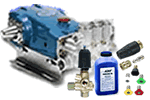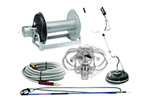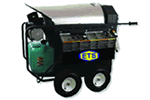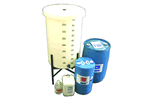Hot Water vs. Cold Water:
Why the difference in pressure washers?
All pressure washers are not created equal. In fact, they fall into one of two very distinct
categories: hot water or cold water.
Because both hot and cold water pressure washers have models with the same (1) flow rate,
(2) pressure and (3) capability of cleaning indoors or outdoors, it begs the question: why do you
need a hot water pressure washer when everything else is the same?
The answer is as close as the kitchen sink.
You’ve just had a spaghetti supper and it’s time to wash the dishes. Fill one sink with cold water
and the other with hot water. Even with a heavy dose of soap in the cold water sink, hot water
will clean significantly better and faster.
Why?
It’s a story as basic as the molecules that make up water.
We learned in our early school years how everything is made up of atoms that bond together to
form molecules. These tiny molecules are in constant motion. Svante A. Arrhenuis (1859-1927),
a Swedish chemist, researched the heat-energy relationship and concluded that the energy from
rising temperatures causes molecules to collide with each other. So as water becomes hotter the
molecules move faster and faster eventually pushing out so far to convert the liquid water into a
gas, or steam. Conversely, as water cools the molecules slow until they become ice.
In other words, hot water is packed with energy that is released into the cleaning equation with a
powerful punch. This energy also causes a reduction in the water’s surface tension so that it can
now penetrate more easily and effectively the molecules of grease and grime.
Actually, there are three key elements–heat, agitation and soap—that successfully remove grease
and grime. Here’s how each works:
• Heat, as described above, creates a high-speed molecular action that causes the cleaning
agent to be more active and reduces water’s surface tension so it can effectively penetrate
grime at the molecular level.
• Agitation is the impact that comes from the water volume and water pressure hitting the
surface—similar to the action of hand scrubbing the dinner plate in your kitchen sink.
• Finally, soap (often referred to by pressure washer users as “detergent”) chemically breaks
the bond between dirt and the surface, such as a floor or metal plate. It starts when the
molecules of oil and grease attach themselves to dirt and keep them trapped or bound to the
surface. Detergents use softening agents, technically referred to as “surfactants” (an
abbreviation for “surface active reagents”) to emulsify the oil and grease. Emulsification is
the process in which two or more immiscible liquids, like oil and water, no longer repel
each other but actually mix. Once the oil and water are able to mix forming an emulsion, the
dirt–still clinging to the oil and grease–is carried away in the wash water.
So what does all of this have to do with a hot water pressure washer? Hot water washers bring
together in perfect balance all three of these key elements—heat, agitation and soap–to deliver
cleaning’s ideal knockout punch.
So how do you know when to use hot water?
If you’re cleaning engines, automotive parts, or anything with oil or grease, you’ll need hot water.
Like the dishes in your sink, hot water “melts” grease and grime; cold water only pushes it
around.
On the other hand, if you’re simply blasting away sand, caked-on mud, or even stripping paint, a
cold-water pressure washer will work just fine. Combined with detergent, a cold-water pressure
washer can be very effective in many applications.
The rule of thumb is simple: whatever cold water cleans, hot water will clean better faster.
Does a hot water pressure washer cost more?
Yes, sometimes as much as two times more, due to the complexity of heating hot water while
under pressure. Hot water pressure washers also require more preventive maintenance, such as
the burner assembly, coil and redundant excess-pressure protection, all of which need annual
tune-ups.
Still, hot water pressure washers easily pay for themselves in labor cost savings via faster, more
effective cleaning. Hot water also saves money by introducing such energy into the cleaning
formula that usually less detergent is needed, thus reducing the cost of a consumable.
How is water heated in a pressure washer?
Water enters a pressure washer from a spigot or tank via a garden hose. It first passes through a
high-pressure pump, which speeds the water on its way through a heating coil, consisting of up to
200 ft. of half-inch, schedule 80, steel pipe or tubing. The helical or circular winding
configuration allows the water to get maximum exposure to the flame (fueled by diesel oil or
natural gas/propane) as it roars through the center of the coil. [For all-electric models, the coil is
immersed in a tank of hot water heated by electricity.] By the time the water rushes out of the coil
and through the wand and nozzle, it will have reached temperatures of up to 200°F.
Don’t I need steam, too?
It’s not unusual to hear hot water pressure washers referred to as steam cleaners. While there are a
few applications such as deicing or disinfecting that require steam, it has been proven over the
years that hot water under pressure is a much more effective method of cleaning than steam.
That’s because hot water washing has the additional benefit of agitation—water volume under
high pressure pounding the surface.
Still, some pressure washers offer a “steam combination” option where the water is super heated
to 280°F in order to create a “saturated steam” effect for those rare applications where there’s a
surface that requires higher temperature cleaning.









